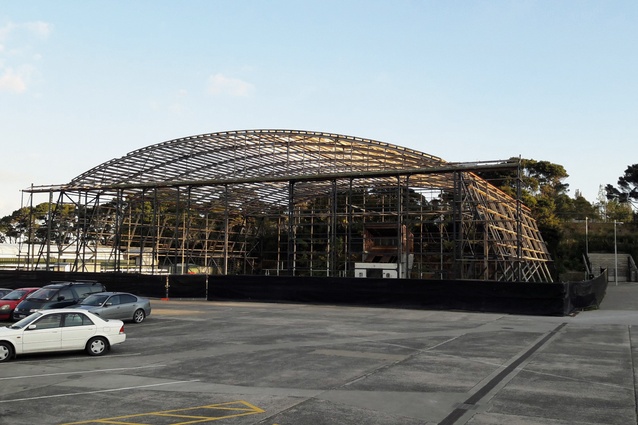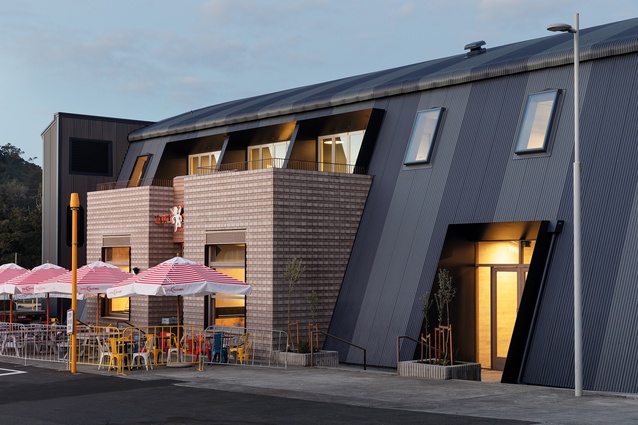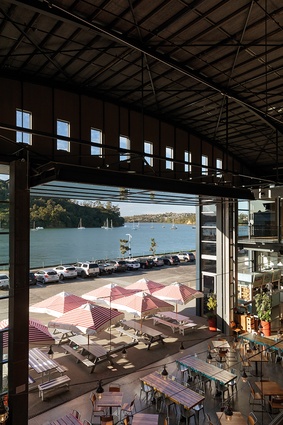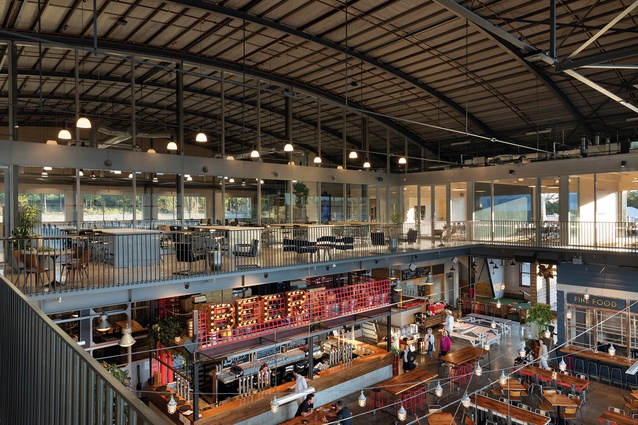Back to the bone
John Sutherland explores Cheshire Architects’ reoccupation of a former seaplane hangar at Hobsonville Point, Auckland.
It’s not often that architects have the chance to dress up a skeleton. But that’s what confronted Cheshire Architects at the 1939 hangar originally built to house the gargantuan Sunderland and Short Empire flying boats at Hobsonville’s Catalina Bay. The centrepiece of a collection of heritage buildings destined for adaptive reuse had been stripped back to its essential structure to remove the asbestos cladding.
It wasn’t the first skeleton on this site to undergo a transformation. That was what is now known as the Catalina Workshop, a building with a concrete façade, diagonally braced hangar doors and riveted steel roof trusses. Now an industrial-chic office space, it was once used for maintaining the Catalinas and Walruses and other flying boats, which were smaller than the Sunderlands.
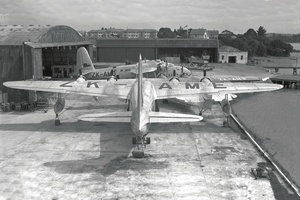
Some history: the massive British flying boats were designed as patrol bombers and played a pivotal role in keeping Britain fed during World War II. The Royal New Zealand Air Force built the hangar to service its newly purchased Short Sunderland aircraft, which arrived from Britain at the Hobsonville airbase in 1944. The aircraft were retired in 1967. (If you want to see a Sunderland, there is one on display at MOTAT.)
The Catalina flying boats, which were housed in a hangar beside the grass airfield, came in 1943 and, after 1945, were scrapped or sold. However, Tasman Empire Airways Limited (TEAL), the forerunner of Air New Zealand, flew a variant of the aircraft modified for passenger use, the Short Solent, from Hobsonville from 1941 before there was a hangar for it.
In its Catalina Workshop makeover, Cheshire used the restored and locked-in-place steel-framed workshop doors as structure for a minimalist and elegant silicone-sealed, double-glazed curtain wall. Internally, there is a bolted, industrial-genre handrail to the stair, which twines itself around the cut concrete wall and protects the first-floor corridor edge while also forming a design connection between the two buildings.
Developer Willis Bond & Co says the project didn’t really start with a written client brief but developed, instead, from plenty of discussions with Cheshire and working up sketch options, which changed over a 12-to-18-month period as different uses were proposed. There was also a formidable challenge for the structural engineers to comply with today’s building code because, until 1991, defence buildings did not have to comply with any building code (NZS 95 would have applied at the time).
Photographs of the hangar before and after its disrobing show the form with and without the corrugated asbestos cladding and roofing. The remaining structural steelwork is remarkably slender, featuring beautifully curved rolled steel joist (RSJ) top chords and bolted-up angles of pre-World War II British steel – too slender by far to remain untouched for today’s standards.
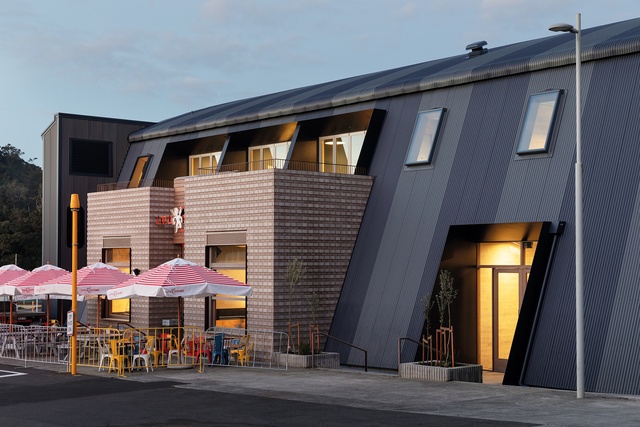
The original Sunderland hangar comprised a long bowstring curved roof with sloping sides and a short projecting structure that contained the sliding and stacking doors when open. Daylight came from matching, corrugated plastic runs in both roof and walls. Cheshire made the excellent decision to retain the bowstring and the sloping sides and, at some stage, the vast interior hangar space was conceived as a mezzanine office space and a food court behind a very large door, which can be opened up on fine days.
To retain access on bad days, an entry set cut between brick towers on the west side provides access and egress (carrying plates) to a sheltered external eating area. The brick coursing and its colour are, together, possibly the least successful intervention Cheshire made on the west side. It sits bolt upright and is a bit fortress-like, as it must be to provide three decks.
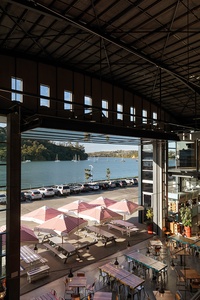
Much more difficult would have been making the move to recess a really big feature door on the north face. The recession enables the insertion of doors at 90 degrees to the façade for inclement weather access from the north.
The feature door is heroic, in that it is set to mechanically fold and rise in two glazed, horizontal panels, and leave a huge, uninterrupted indoor/outdoor space for sitting at tables, eating and drinking. On a fine weekend day, the place is heaving. Inside, food and drink are prepared and dispensed on three sides by a variety of franchises. Cheshire had little or nothing to do with these stage-set eateries, which were the result of direct commissions to Ignite Architects by the franchise-holder brewery. Behind the main bar, beneath the mezzanine, there is a mini, all-stainless-steel brewery for Little Creatures craft beers.
The big door itself is set and hoisted within a portal of welded-up square hollow section (SHS) steel, which the engineers also used to stabilise the north façade as a whole and is a serious bit of structural design.
Achieving the balance of mezzanine floor area to full-height void was key to making the project work. The result is 1200 square metres of mezzanine used as commercial and co-working office space. Willis Bond & Co decided on three kinds of spaces for hire. On the west side are three medium-sized meeting rooms, separated from one another by sliding, folding acoustic doors, and each opening onto a timber-floored external deck. On the east side are studios plus bathrooms for the whole mezzanine.
The rest of the mezzanine provides co-share desking and commercial services. All these spaces have been contained behind elegantly proportioned glass panels and heavy section aluminium-framed partitions. The smaller side rooms have ceilings while the large co-share space has neatly exposed services hung from above.
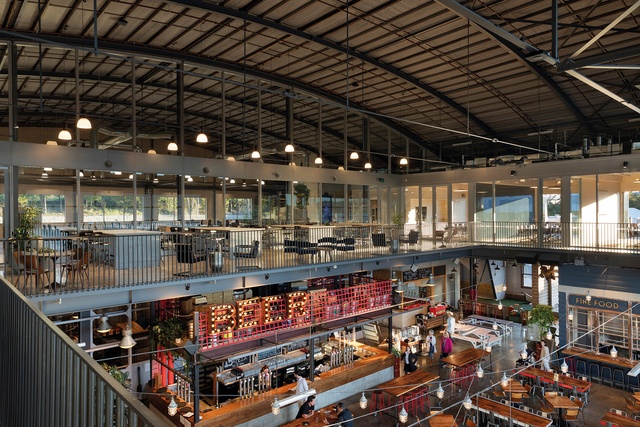
The mezzanine structure consists of exposed structural steel columns, beams and inverted-V bracing, with a solid concrete slab on steel trays or a pre-cast panel floor system over the brewery. Again, this new structure provides stabilisation for the original, retained steel skeleton.
A decision was taken to keep the two kinds of occupant (office worker and diner) apart and the mezzanine is accessible only from the outside west face by its own stair or lift. This insertion of another new element into the sloping side, by comparison, provides a beautiful set of details, using 12mm aluminium solid plate sides to the start of the tunnel with a dramatic means of handling the gutter above.
As it was originally, the hangar is clad and roofed with a corrugated profile. But, this time, it is prefinished steel in two blues: predominantly dark while the lighter blue and high-level windows mimic the transparent panels of the original.
Congratulations to both Willis Bond & Co and Cheshire for their dressing of this remarkable structural skeleton into a vibrant food-and-beverage destination plus workspace. But, to really complete this transformation and to make the most of the drama of the massive hangar door opening, it would be good to see the threshold between inside and outside as something more than a thin line of outdoor tables. Cheshire should be put to work to solve this problem; it could well mean a rethink of the car-parking and the resurfacing of the hard in general.
This article first appeared in Architecture New Zealand magazine.




